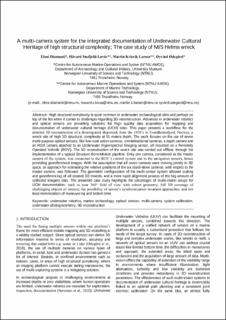| dc.contributor.author | Diamanti, Eleni | |
| dc.contributor.author | Løvås, Håvard | |
| dc.contributor.author | Larsen, Martin Kvisvik | |
| dc.contributor.author | Ødegård, Øyvind | |
| dc.date.accessioned | 2022-03-01T10:32:39Z | |
| dc.date.available | 2022-03-01T10:32:39Z | |
| dc.date.created | 2022-02-03T09:05:12Z | |
| dc.date.issued | 2021 | |
| dc.identifier.citation | IFAC-PapersOnLine. 2021, 54 (16), 422-429. | en_US |
| dc.identifier.issn | 2405-8963 | |
| dc.identifier.uri | https://hdl.handle.net/11250/2982027 | |
| dc.description.abstract | High structural complexity is quite common in underwater archaeological sites and perhaps on top of the list when it comes to challenges regarding 3D reconstruction. Advances in underwater robotics and optical sensors are providing solutions for high quality data acquisition for mapping and documentation of underwater cultural heritage (UCH) sites. This paper presents a workflow for the detailed 3D reconstruction of a disintegrated shipwreck from the 1920’s in Trondheimsfjord, Norway, a wreck site of high 3D structural complexity at 55 meters depth. The work focuses on the use of seven multi-purpose optical sensors, like low-cost action cameras, omnidirectional cameras, a depth camera and an RGB camera attached to an Underwater Hyperspectral Imaging sensor, all mounted on a Remotely Operated Vehicle (ROV). The 3D reconstruction of the wreck site was carried out offline, through the implementation of a typical Structure-from-Motion pipeline. Only one camera, considered as the master camera of the system, was connected to the ROV’s control system and to the navigation sensors, hence providing georeferenced images. With the assumption that all seven cameras were moving jointly in 3D space, an approach for estimating the relative positions of the six stand-alone cameras, with respect to the master camera, was followed. The geometric configuration of the multi-sensor system allowed scaling and georeferencing of all created 3D models, and a more rapid alignment process of the big amount of collected imagery data. The presented case study highlights the advantages of multi-vision setups for UCH documentation, such as near 360° field of view with robust geometry; full 3D coverage of challenging objects of interest; the possibility of sensor’s synchronization invariant approaches, and not least minimization of maneuvering and bottom time. | en_US |
| dc.language.iso | eng | en_US |
| dc.publisher | International Federation of Automatic Control (IFAC) | en_US |
| dc.rights | Attribution-NonCommercial-NoDerivatives 4.0 Internasjonal | * |
| dc.rights.uri | http://creativecommons.org/licenses/by-nc-nd/4.0/deed.no | * |
| dc.title | A multi-camera system for the integrated documentation of Underwater Cultural Heritage of high structural complexity; The case study of M/S Helma wreck | en_US |
| dc.type | Peer reviewed | en_US |
| dc.type | Journal article | en_US |
| dc.description.version | publishedVersion | en_US |
| dc.source.pagenumber | 422-429 | en_US |
| dc.source.volume | 54 | en_US |
| dc.source.journal | IFAC-PapersOnLine | en_US |
| dc.source.issue | 16 | en_US |
| dc.identifier.doi | 10.1016/j.ifacol.2021.10.126 | |
| dc.identifier.cristin | 1997244 | |
| dc.relation.project | Norges forskningsråd: 223254 | en_US |
| cristin.ispublished | true | |
| cristin.fulltext | original | |
| cristin.qualitycode | 1 | |

